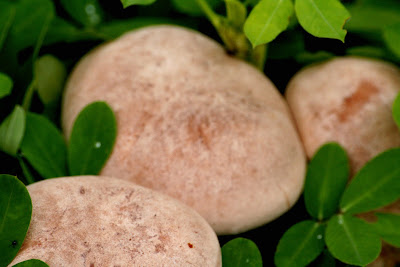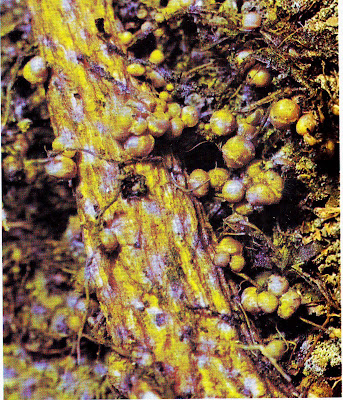Homeostasis - Dynamic Balance of Nature
Homeostasis refers to dynamic equilibrium, the ability of certain organisms or systems to maintain long term balance in spite of changes taking place in the environment over time. Here are some agents of Nature that help bring about such dynamic balance.
Homeostasis refers to dynamic equilibrium, the ability of certain organisms or systems to maintain long term balance in spite of changes taking place in the environment over time. Here are some agents of Nature that help bring about such dynamic balance.
Dr Abe V Rotor
Living with Nature School on Blog
for the use of plants. Note tubercles in lower photo where the
beneficial bacteria reside.

2. A host of soil insects, principally crickets and grubs, was
responsible in toppling this tree. Caliraya Lake, Laguna.
 5. Moss builds soil from rock, an example of biological weathering.
5. Moss builds soil from rock, an example of biological weathering.Calaruega Retreat Center, Alfonso, Cavite
 6. Termites eat wood with the aid of protozoa that live in
6. Termites eat wood with the aid of protozoa that live intheir stomach, an ideal example of symbiosis.
 7. Termite mound covers a tree stump, which ultimately become soil.
7. Termite mound covers a tree stump, which ultimately become soil. Parks and Wildlife Nature Center, Quezon City.
 8. Mushrooms grow on plant residues, and convert them into
8. Mushrooms grow on plant residues, and convert them intohumus which fertilizes the crop. Antipolo, Rizal
 9. Shelf mushrooms grow on dead wood, eventually converting
9. Shelf mushrooms grow on dead wood, eventually convertingit into soil that piles up on the forest oor. Mt. Makiling, Laguna
.jpg)
10. Rot fungi blanket the dead limb of Ficus tree.
UST Manila.
11. Drynaria Fern and acacia tree in a state of mutualism
(symbiosis) favorable to the longevity of both symbionts.
12, Nymphaea and Cuperus are Nature's water purifiers, now used in
bioremediation - the cleaning of polluted bodies of fresh water.
(Detail of Mural by AVR)
13. Ants are efficient predators of a wide range of pests.
They maintain a favorable balance of the food web and ecosystem.

14. Garden slug feeds of algae and organic waste - it is Nature's janitor.
11. Drynaria Fern and acacia tree in a state of mutualism
(symbiosis) favorable to the longevity of both symbionts.
12, Nymphaea and Cuperus are Nature's water purifiers, now used in
bioremediation - the cleaning of polluted bodies of fresh water.
(Detail of Mural by AVR)
13. Ants are efficient predators of a wide range of pests.
They maintain a favorable balance of the food web and ecosystem.

14. Garden slug feeds of algae and organic waste - it is Nature's janitor.
15. Yeast is ubiquitous, Nature's agent of fermentation. Sugar is converted
into ethanol and acetic acid, which ultimately break into elements.
Lesson, Former Paaralang Bayan sa Himpapawid (People's School-on-Air) 738 DZRB AM Band,







No comments:
Post a Comment